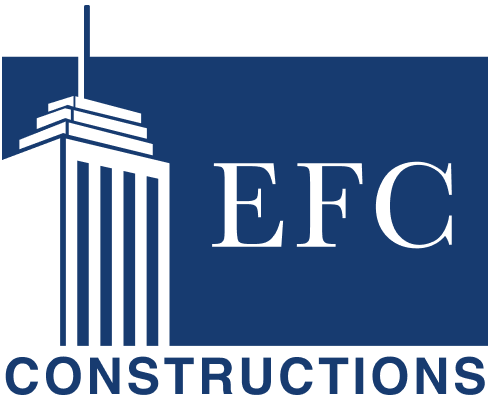How much, on average, does it cost to build a house in 2022?
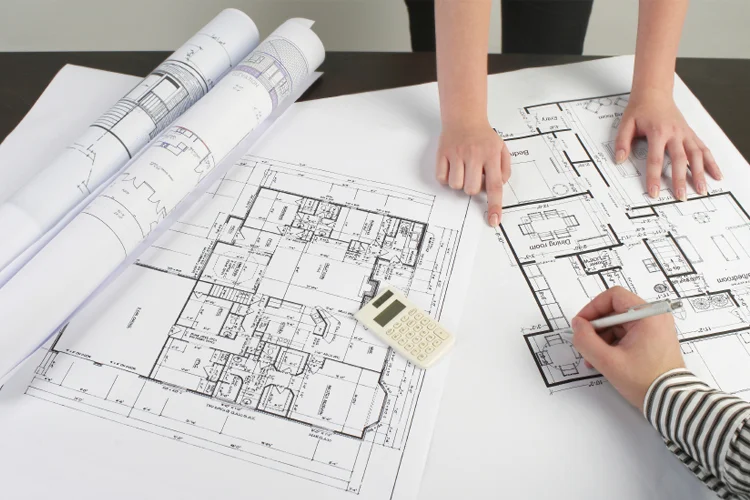
In Australia today, how much can you expect to spend when building a house?
If you’re dreaming of building a new home, you may be wondering how recent events have impacted house construction prices including builder’s costs and stamp duty fees. Without sounding trite, the answer to this could be summed up with that frustrating yet often accurate phrase: how long is a piece of string?
There are a number of different factors that can impact the cost of building a house, including but not limited to:
- the size of the dwelling
- the location and availability of resources the slope of the land
- the quality of the fixtures and fittings
With this in mind, there are some “ballpark figures” I can come up with, to give you a guide as to how much it may cost you to build a property.
But before I do, let’s look at…
How COVID-19 has impacted costs when building a house?
While it’s hard to be clear exactly how much COVID-19 has impacted costs when building a house, it’s fair to say that with so many changes, border closures, and restrictions it has changed the landscape.
Thanks to volatile exchange rates, supply chains being impacted, and reduced productivity due to COVID-19 restrictions, costs have risen and the time to complete projects has dragged out pushing up the cost of construction.
The shortage of materials and labour is likely to significantly increase housing construction costs over the next couple of years.
Believe it or not, despite all the trees we have in Australia, prior to Covid-19 roughly 20% of Australia’s structural timber came from abroad, mostly from Europe.
Timber prices have risen 30 to 40% over the last few months and this is phenomenal we are seeing around the world.
The boom in residential construction here during the COVID-19 pandemic had coincided with a surge in construction in major overseas markets like the U.S. and Canada, meaning overseas suppliers had been unable to meet this shortfall during the pandemic.
Over the past 2 years the extremely strong demand for detached housing across Australia has been primarily driven by government stimulus in response to the pandemic and historically low interest rates.
While COVID-19 has caused major disruptions to the supply of building materials, it is important to remember that there have also been bushfires in Victoria in 2019 (which destroyed timber) and floods in Queensland and NSW in 2022 (which have further delayed several supply chains).
Valuers Charter Keck Cramer has considered the Australian Bureau of Statistics (ABS) price indices of residential housing across Australia to understand the change in prices across various materials used in the construction of housing. Some key take outs include:
- Price increases across various items, in several states, are the highest since the introduction of the GST in 2000 (or in some instances since the GFC in 2008/2009). This has led to an overall increase in costs across Australia (across all price groups tracked by the ABS) of +13.6% since the start of COVID-19.
- The items that have increased the most are timber, board and joinery (such as structural timber, timber doors and windows, plywood and board) as well as steel products (such as steel beams and sections and reinforcing steel).
- It is observed that timber, board and joinery has increased the most in Adelaide whilst steel products have increased the most in Brisbane.
Here’s an idea of what has happened to construction costs around Australia
Charter Keck Cramer have provided the following graphics to show the change in what it cost to build a house around Australia.
Change in construction costs in Sydney
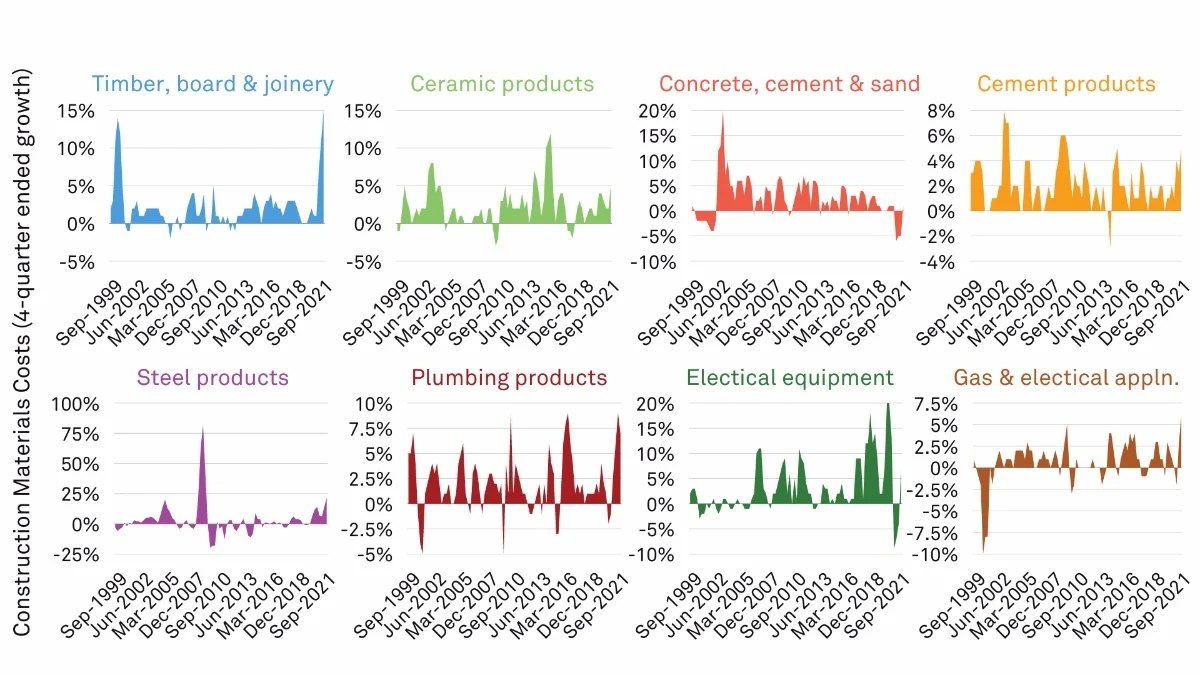
Change in construction costs in Melbourne
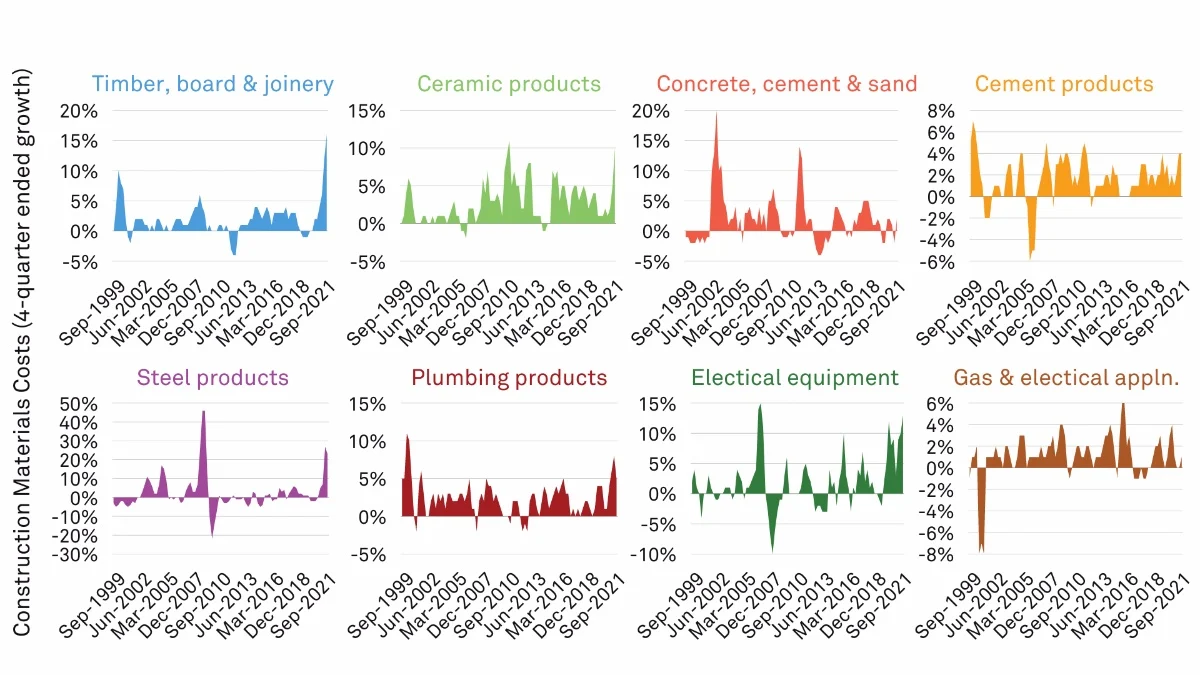
Change in construction costs in Brisbane
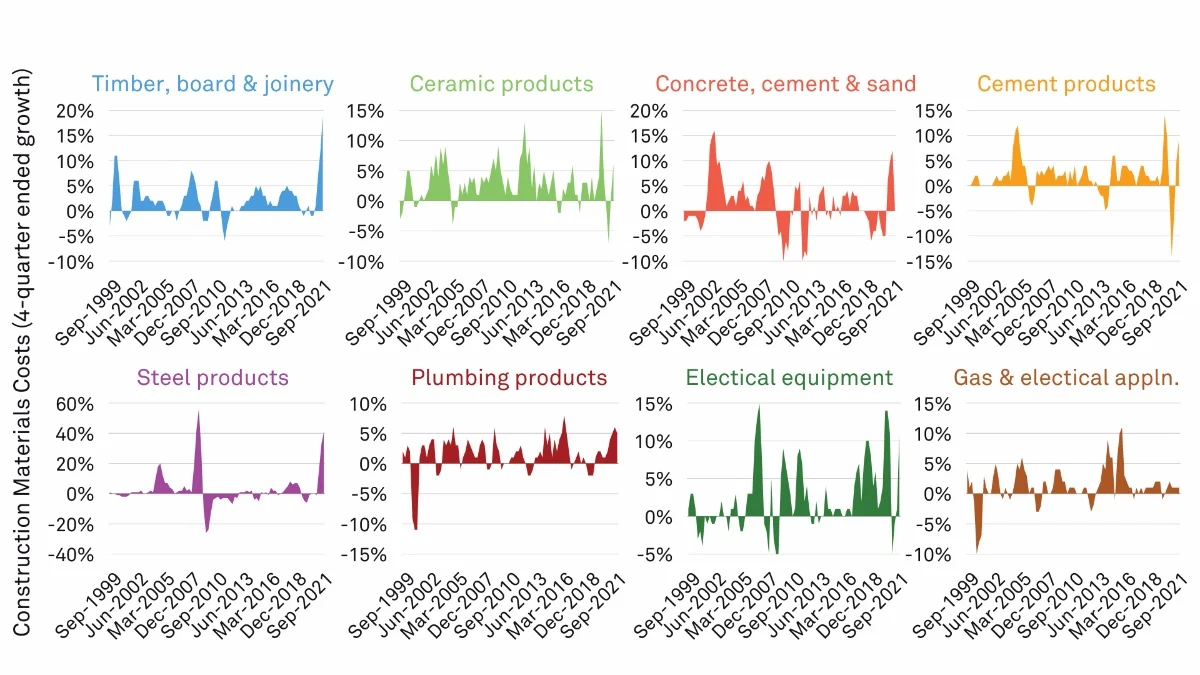
Change in construction costs in Adelaide
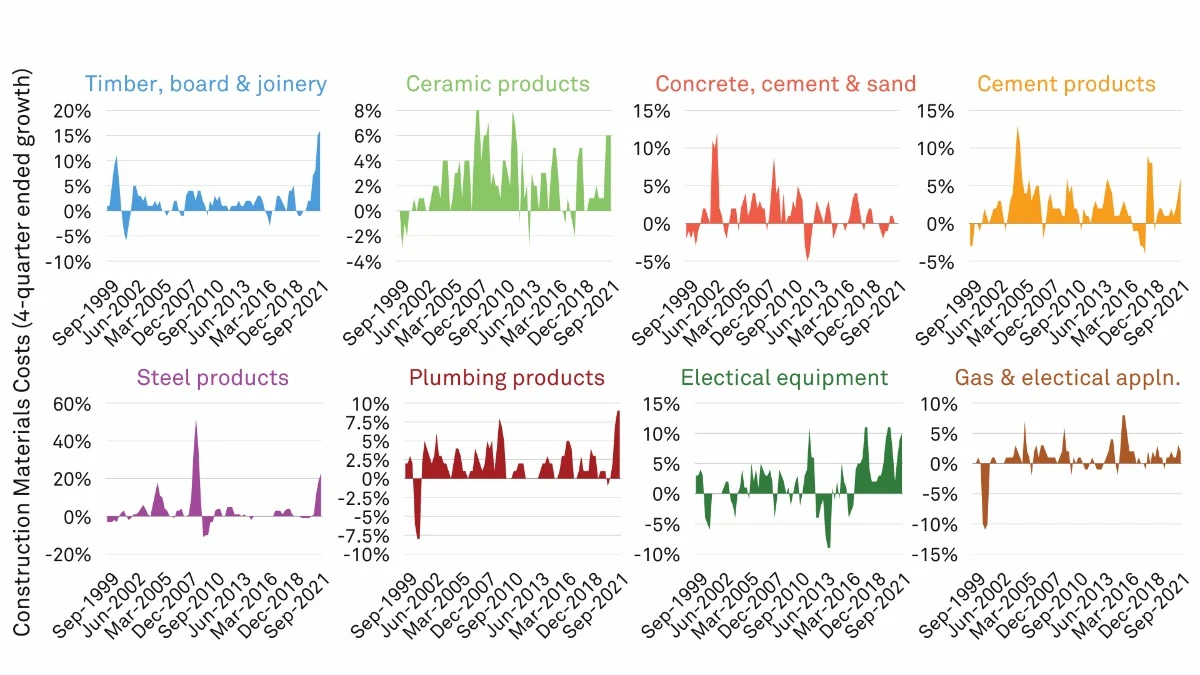
Change in construction costs in Perth
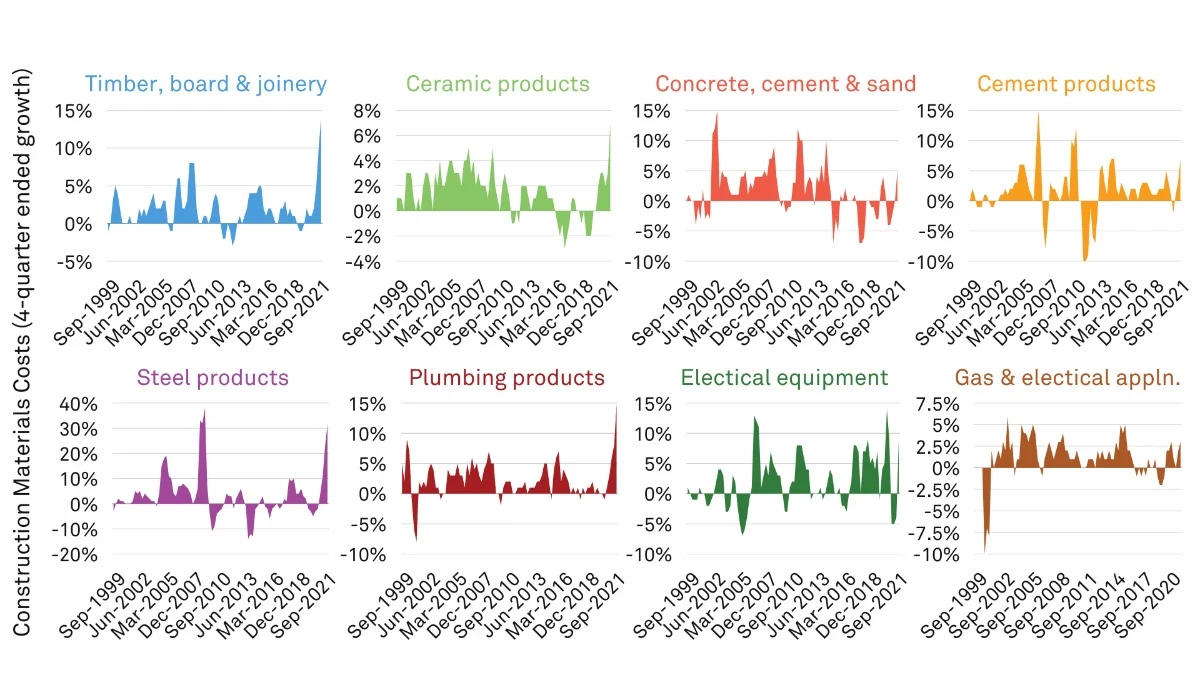
What the recent government stimulus has done to building costs?
HomeBuilder and other state-based programs have provided extensive support to the housing sector, particularly for detached housing as opposed to apartments.
With new contracts now no longer eligible for the HomeBuilder scheme, it is conceivable that the level of dwelling approvals will soften from here.
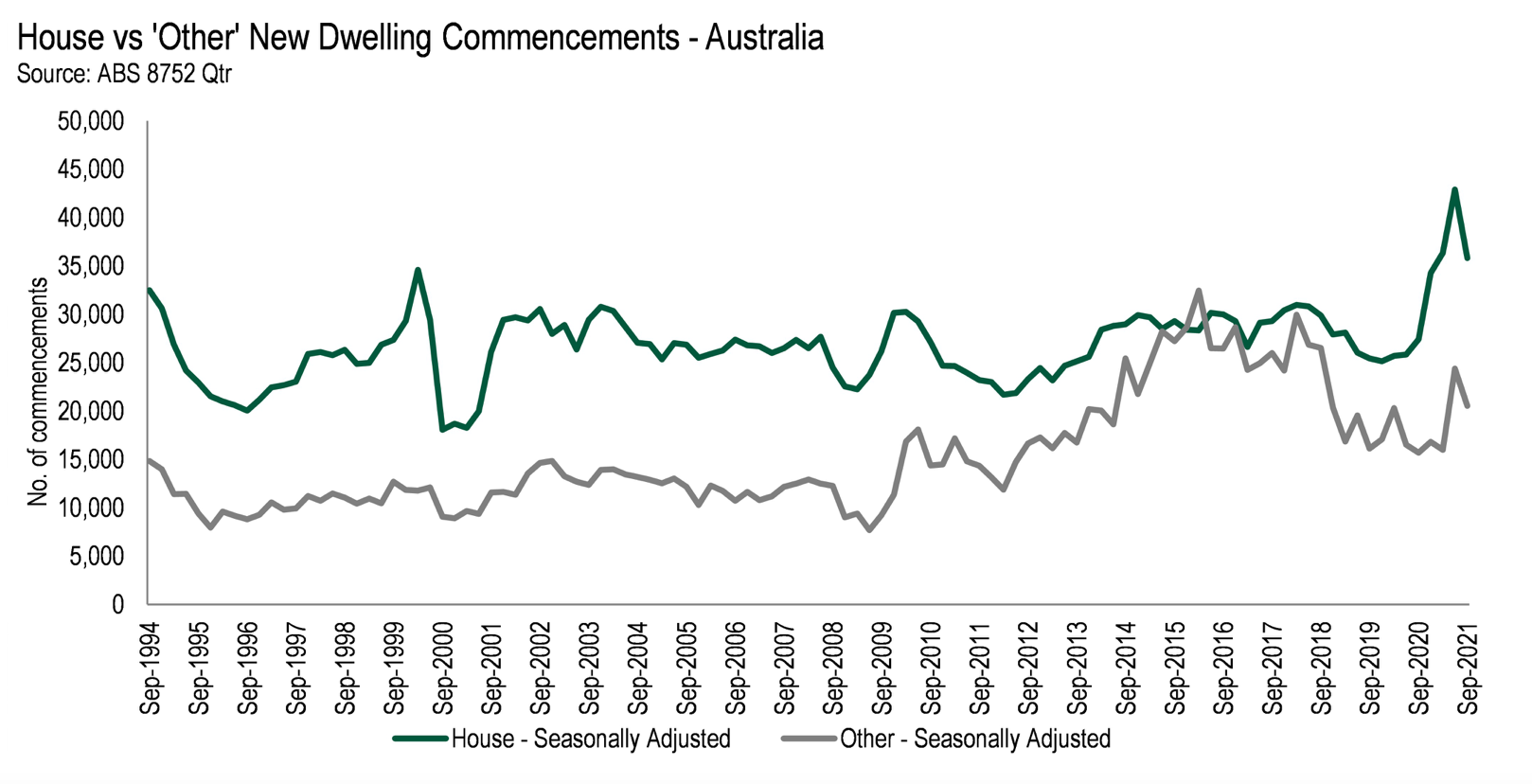
Demand for new detached and multi-unit housing has remained strong, suggesting that the current boom in home building will be sustained throughout 2022.
However the full impact of the loss of migration is yet to fully impact demand for detached housing and a rise in interest rates will mark the end of this COVID building boom.
HIA Chief Economist, Tim Reardon said:
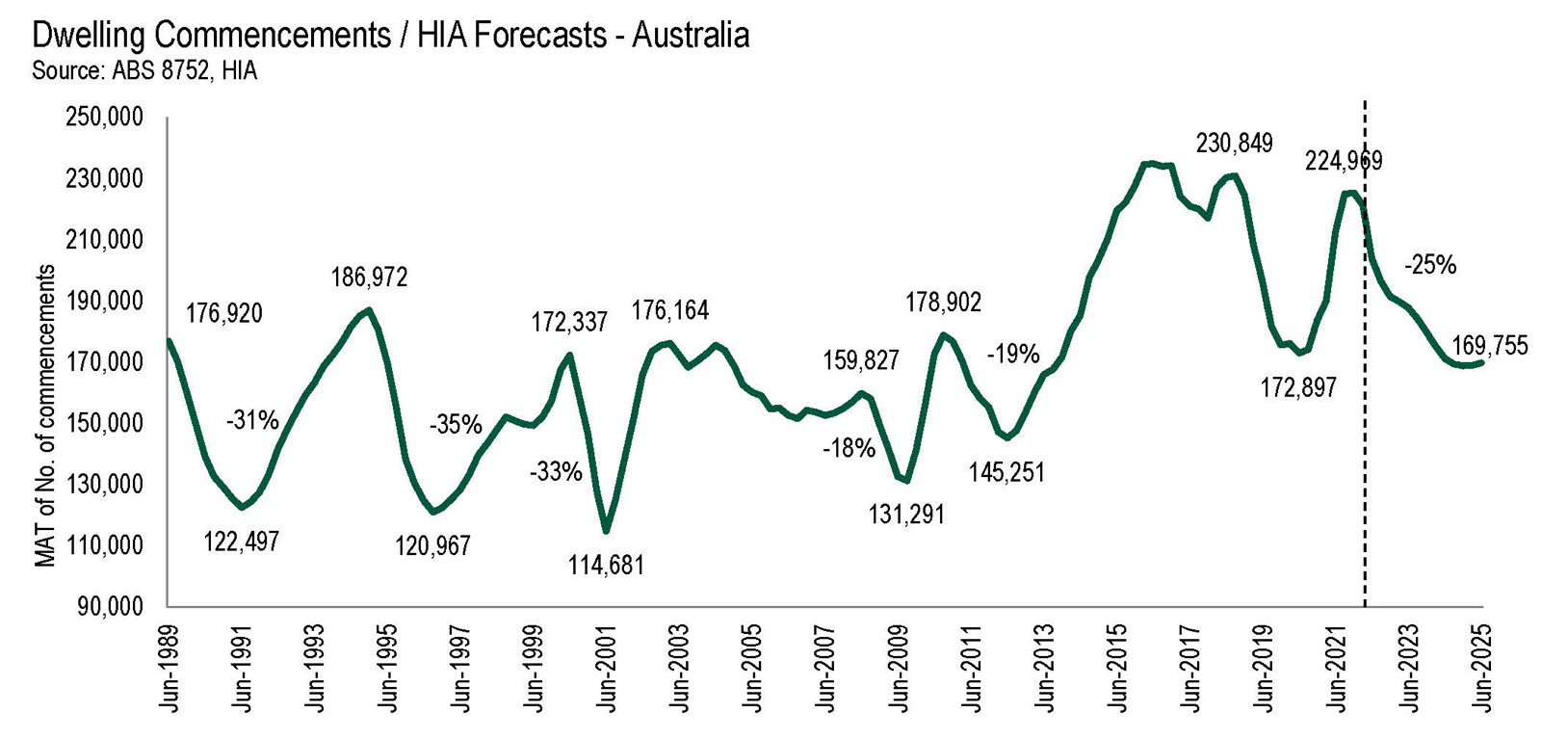
More detached homes commenced construction in the 12 months to September 2021 than in any previous period and this building boom has created major challenges in the supply chains for builders, meaning some projects can’t start on time, hitting customers with significant delays and pushing up the price of materials.
And disruptions to international supply chains are only making matters worse.
However, a range of other factors are also playing a role in increasing building costs including:
- rising shipping costs for materials from overseas due to a shortage of empty containers because of Covid-19,
- rising labour costs due to a shortage of skilled labour,
- record low interest rates and a national housing shortage causing an unprecedented demand for new housing stock across the country.
Although HomeBuilder has now been phased out at the end of March 2021, it’s highly likely we will see a continuation in this trend towards higher residential construction costs as it will take some time for builders to work through the surging pipeline of house approvals.
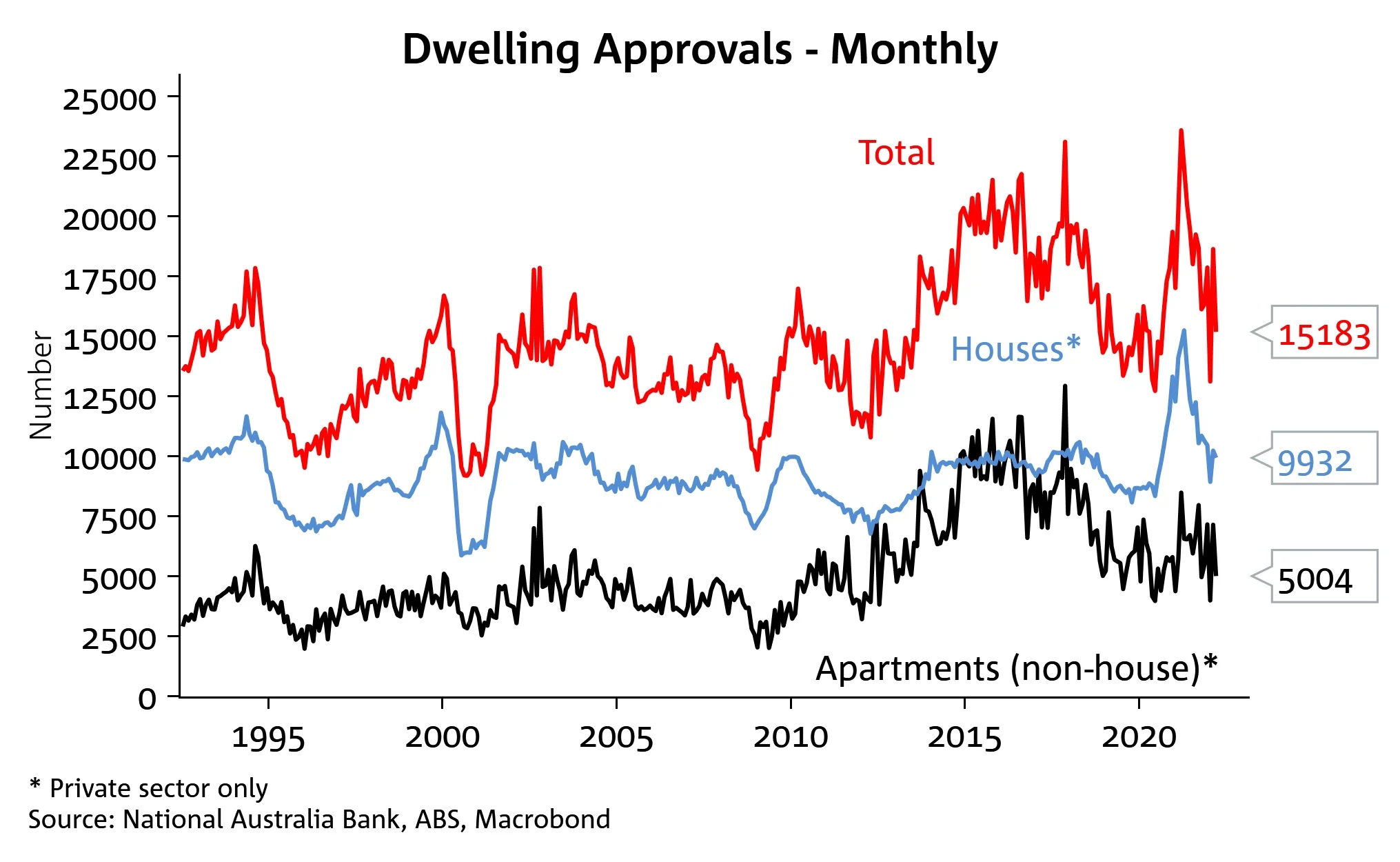
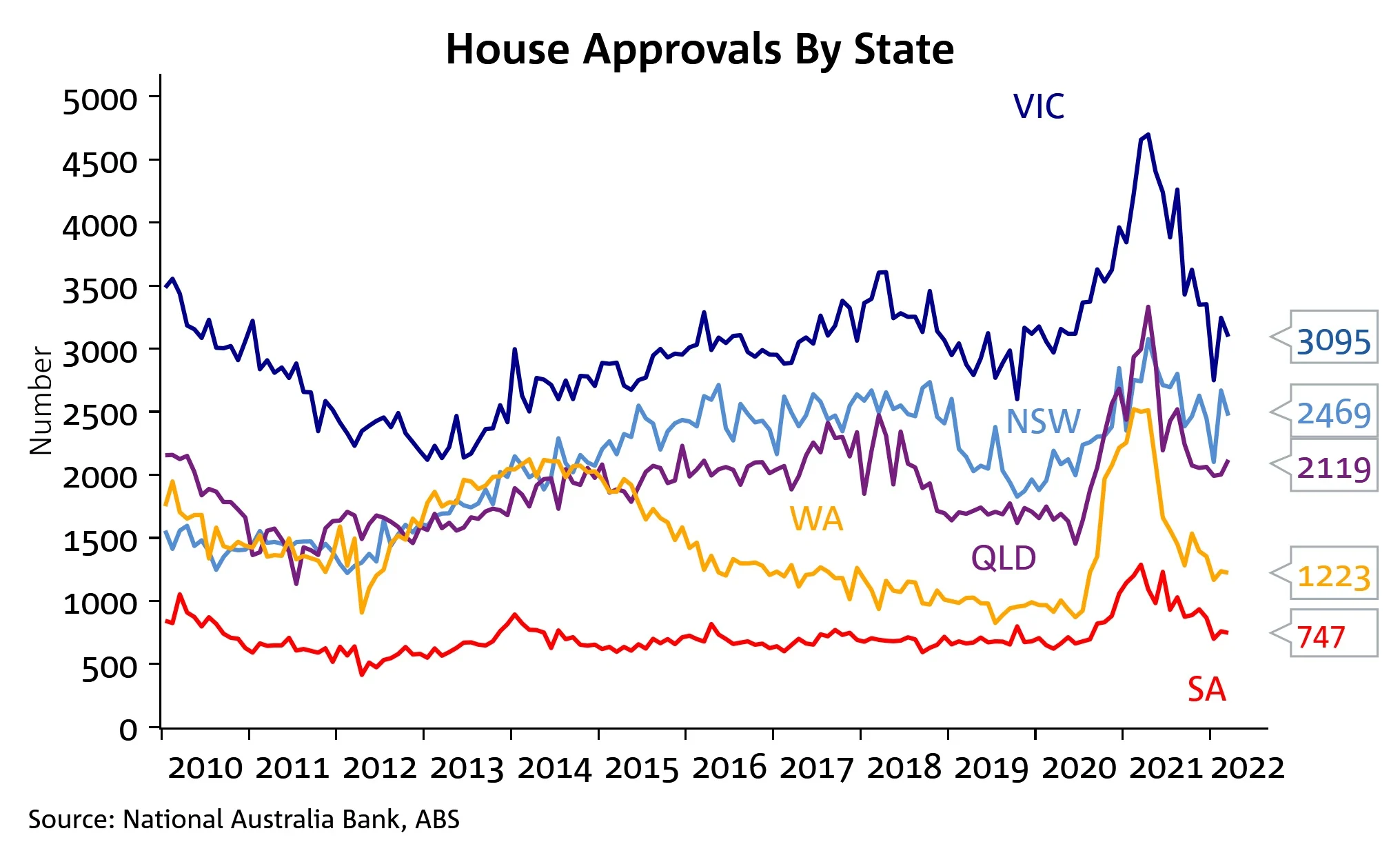
Housing construction costs
Building costs across all major Australian markets are growing faster than inflation – a trend that looks set to continue for years due to construction demand outstripping supply for both labour and materials.
Disruptions caused by COVID-19 are largely to blame with global supply chain issues negatively impacting both material delivery and pricing, while state and international border closures have led to intractable labour shortages.
The Cordell Housing Index Price (CHIP) which measures the rate of change of construction costs within the residential market says that residential construction cost have risen 1.1% over the three months to December 2021, after the three months to September 2021 so I significantly larger than usual quarterly increase (3.8%)
As you can see from the chart below, nationally The Cordell Construction Cost index Rose 7.3% over 2021, while the CPI only increased by a much smaller amount.
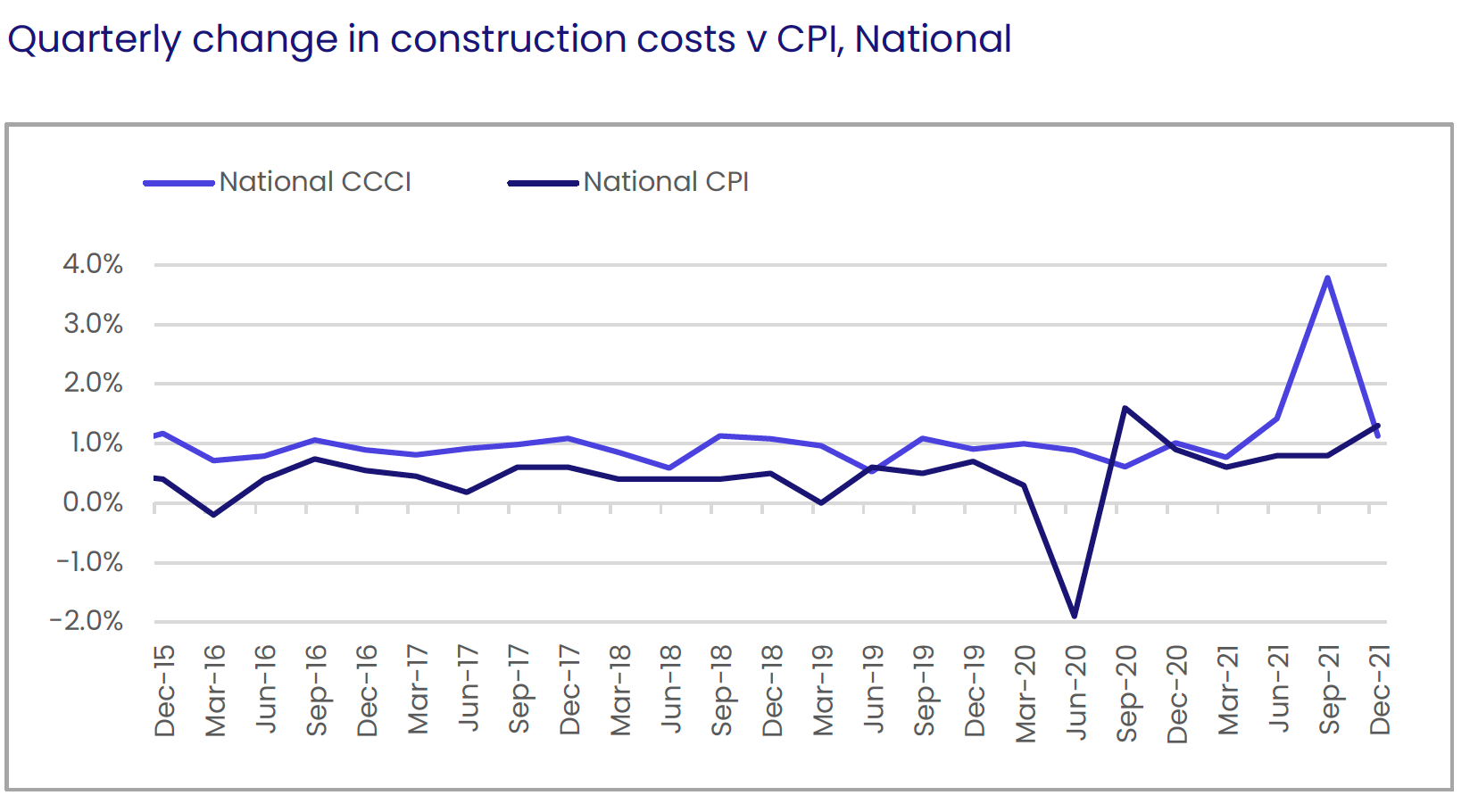
CoreLogic Research Director Tim Lawless says the smaller rise over the quarter might reflect some rebalancing in the index after Q3’s jump, however the data company is expecting growth in residential construction costs to remain above average over the coming quarter as supply chain disruptions persist.
The following chart shows the categories measured within the CHIP index.
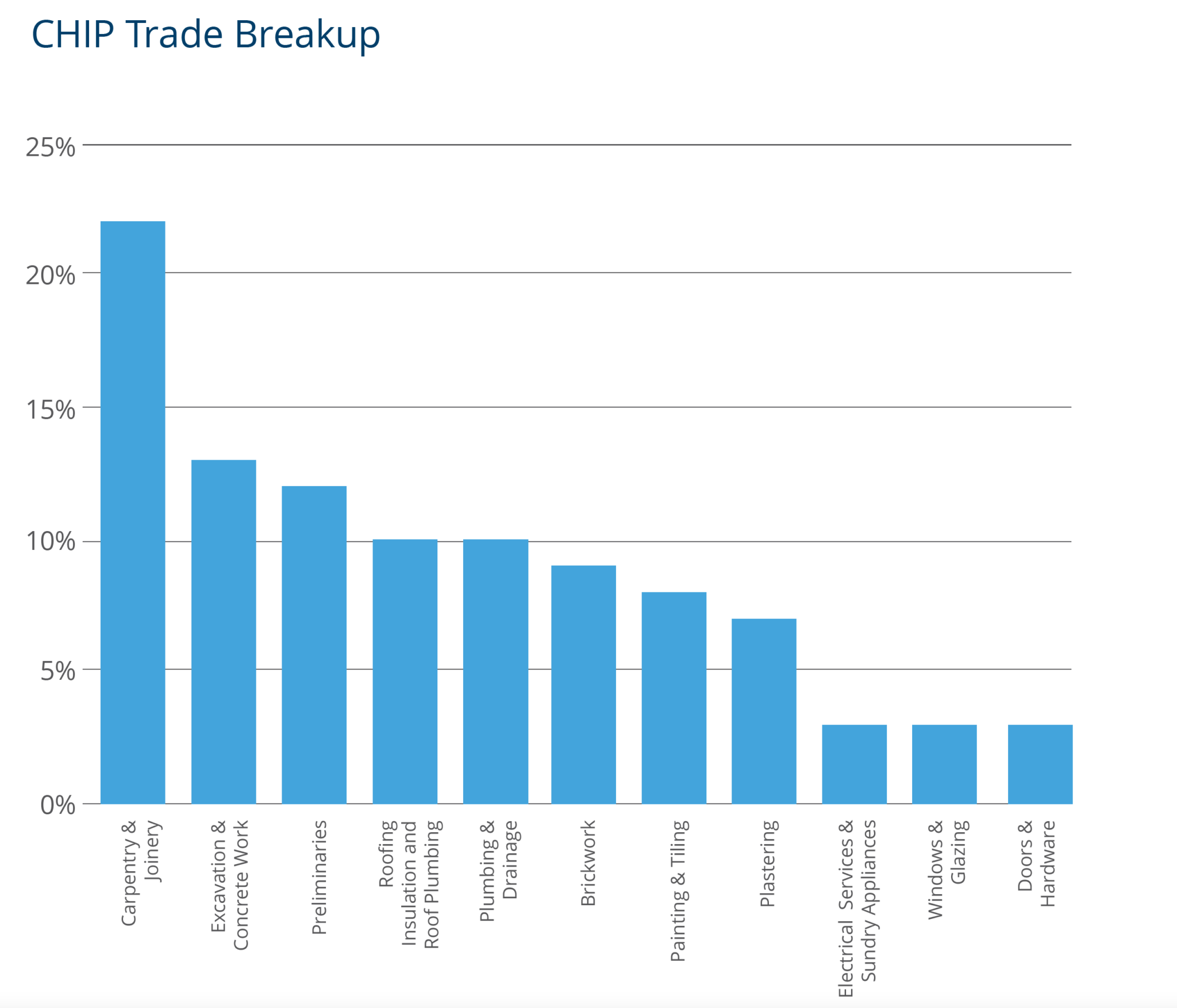
So how much can you expect to pay?
First up, let’s get one thing clear: the base price that builders advertise on billboards and display on their websites is generally only a starting point, and does not reflect how much your home will actually cost when it’s 100% completed.
This is because these “starting from” prices usually only include the basics.
If you are looking for a complete price that includes everything from the carpeting through to the landscaping and driveways as well as the white picket fence at the front, then you need to shop around for what’s known as a “turn-key” package – which means all you need to do at the end is turn the key and step inside.
The cost of building a house varies widely, particularly depending on where in Australia you are planning to build.
And as mentioned, the size of the property and the quality of the finishes will impact the final price, too.
According to ABS December 2019 Buildings Approvals data, the Australian average was $1393.55 per sqm.
However, this figure doesn’t include design, planning permits, any site works, or any cost blow-outs.
With the average dwelling in Australia being 229.8sqm, this puts the cost for the build portion alone at $320,238.
Look at the guideline below, according to BuildSearch.
- Average costs to build a new project home
- Calculating the average price to build a house in Australia
- A budget-style, basic home:
- A standard home:
- A premium, higher end home:
- Provisional Sums
- Prime Costs

Obviously one can’t really compare the cost of an architecturally designed home to one built by volume builder for his little $1600 per square metre.
For a very high-end home with custom-designed finishes and tailored design, you can expect to pay much more – anything from $3,000 to $5,000 per square metre and up.
It’s all well and good to get a ‘per square metre’ indication of price – but how do you translate that into actual costs, to give you an understanding of how much you’re going to pay to construct your new home or investment property?
There’s no point in going to the bank and saying, “I need to borrow $1190 per square metre”; they’re going to need a little more info to go on than that!
To help you understand the full costs of building a house, we’ve run the numbers on a standard home build of around 150-170m2.
Based on this sizing, if you wish to build a three- or four-bedroom home with one or two bathrooms, prices typically start as follows:
From $200,000 for a 3-bedroom home and from $230,000 for a 4-bedroom home. For a turnkey package, add approximately $18-20,000.
From $250,000 for a 3-bedroom home and from $285,000 for a 4-bedroom home. For a turnkey package, add approximately $20-22,000.
From $300,000 for a 3-bedroom home and from $350,000 for a 4-bedroom home. For a turnkey package, add approximately $22-25,000.
Adding an additional story can add around $100,000 ~ 120,000 to the cost of construction.
Learning the lingo:
When you go through the process of building a home, you’ll come across plenty of industry jargon that can be tricky to understand – and even trickier to price.
Here are a couple of terms that may be included in your building contract, which are important to understand.
A provisional sum is an estimated amount of money that is determined by the builder, according to how much they believe the relevant job or material will cost.
Build MoneyOften the builder can’t put a fixed cost on certain parts of the job at the time of providing a quote or signing the building contract because of unknowns.
For example, while your site may look flat and the builder quotes as such when staring the works, they may discover large clumps of rock that need to be removed and leveled prior to the slab being laid.
Or when the builder starts digging your foundations they realise they have to dig down further to hit firm footings, which will eventually require more concrete to be poured.
At times like this, you’ll need to pay an additional sum on top of the initial contract price, as the allowance that had been provided has been exceeded.
Note: It is always a good idea to budget for around 10% of the total build price to allow for fluctuations in provisional sum prices.
A prime cost is an item that is subject to change during the construction of your home.
These include things like fixtures and fittings such as tiles, doors and taps, as these items may change depending on your final choice.
You’ll find an estimated amount is provided when signing the building contract, and then depending on your specification of the finishes during the build, these prime costs items may cost more or less if you elect to change them along the way.
Note: these items generally only change due to your change in preferences, so this could be an opportunity to trim costs if you opt for basic or standard fixtures, fittings and finishes.
What other costs can you expect to pay when building a house?
As mentioned earlier, there are a number of costs that come into play when building a house.
For a standard brick home without any custom finishes, you may be able to come up with a fairly clear budget.
However, once you start factoring in extras such as landscaping, driveways, retaining walls, fences, and upgrades finishes, and fittings, your costs can increase significantly.
These are some of the additional expenses to look out for may include:
- Site Costs
- Connections to services such as water, sewer, electricity, and gas
- Fences
- Retaining walls
- Site clearance (trees, roots, bushes)
- Site survey
- Soil tests
- Other factors that can impact the price
- Roof: depending on the materials you choose for your roofs, such as tiles or colorbond, this can vary widely
- Tiling: an allowance for a tiling amount per sqm will be made, but this can change depending on the quality and size of your final choice.
- Fixtures and fittings: fancy, nonstandard taps, and European appliances will obviously cost more than standard Australian-made fixtures and fittings. Additionally, labour costs may increase if you select items that are more complicated to install. Inclusions such as fully ducted air conditioning can cost up to $10,000 (more for a two-storey home).
- Kitchen: If you’ve ever shopped for a kitchen benchtop, you know how widely the costs of a kitchen upgrade can vary. Again, the final price will depend on the quality of the item you choose and what is in your initial specification in the contract.
- Electrical: If you decide to change your lighting layout from what has been initially drawn, this can add costs. For example, if the specifications in your contract allow for one standard light per room but you wish to have multiple downlights, this extra cost can add up.
- Extra costs you should allow for
- Soil Quality – One of the first things your engineers will organise is a soil test. They do this by drilling some bore holes and the best classification you can get is M classification soil. If your soil is more difficult to work with eg. Clay, Sand or Rock then you’re likely to have to pay extra.
- Slope of the block – The easiest site to build on is a flat block. If your block slopes you’re likely to have to pay extra for more foundations, or to cut and fill the site (make it flat) and possibly for retaining walls.
- Flood prone areas – some sites require the house to be raised with the floor level above natural ground level to cope with excessive rain or floods and this can add to the construction cost.
These are the expenses that are incurred to prepare your block of land before construction can even commence.
These are usually completed by your builder and in most cases, the site costs are charged on top of the build price.
Site costs for an average block of land can hover around the $15,000 to $25,000 mark, however again, the location, size, and slope of the block of land can have a substantial impact on the final charges.
Some of the typical expenses involved in a site cost can be:
Once you have signed a contract with a builder and decided on the layout and design of your property, they will make plans and prepare documents, before arranging a ‘pre-start meeting’.
The pre-start meeting is at the stage at which your house plans are finalised.
They are approved by the council and you are ready to make your final choices in regards to all of the design aspects, such as wall colours, the types of light fittings, and the materials used on the roof and on floors.
The ‘prime costs’ are generally already in place by the builder, however, keep in mind that in base contract packages, the prices factored in often account for the cheapest materials, the most basic fittings, and the most standard fixtures.
If you wish to change any of these, you could incur an extra cost.
Some of the parts of the home that you may wish to ‘upgrade’ during this process include:
Some extra costs you need to take into account and which could end up costing you a significant amount of money include:
Contract variations
The final thing can impact your build price is variations, which are changes to the contract which are made after you have signed it.
Bulid HouseThe good news is, there is often an opportunity to change your mind as the build progresses if you really want to; perhaps you’ve been thinking about that glass splashback in the kitchen and decided it’s really not a good idea.
The bad news is, it will cost you!
Variation costs are costs you want to avoid where possible, as builders usually have a mark-up of about 20%-25% on variations.
On top of this, builders usually charge a variation fee of $250 each. These fees should be set out in your contract.
What’s the average time to construct a home in Australia?
There are too many variables associated with the time it takes to construct a house in Australia, making it virtually impossible to give an accurate time frame to build a house.
One-off custom-built homes take longer to build the turnkey display homes which can often be built in 6 months.
And currently, there are ongoing construction delays associated with COVID-19, only adding to the time taken to build a house.
Then, there are the unforeseen hurdles that always seem to arise when building – things like unfavorable soil conditions such as rock removal, bad weather, or waiting for certain permits or approvals.
Having said all of that, the average time to build a two-storey house is roughly 10 -12 months.
In conclusion
While the cost of building to build home has clearly increased, the price of purchasing an established home in Australia has skyrocketed, with the value of many homes increasing by more than 20% this year alone.
The average cost of building a house varies due to a range of factors, including size, location, and quality of fixtures and fittings.
While I’ve tried to give you estimates the final price will depend on whether you chose a display home that the builder has designed with cost efficiency in mind, or a unique home- your own special castle which has never been built before.
